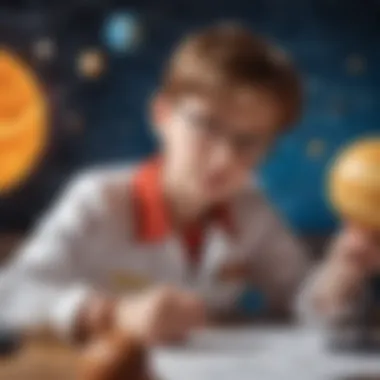Discover the Wonders of Stars and Planets with this Young Scientist's Guide


Science Fun Fcatssss
In the vast expanse of the universe, there exist many intriguing tidbits of information about stars and planets that may spark your interest. Did you know that some stars emit different colors based on their temperature? This phenomenon is known as stellar classification and helps astronomers understand the characteristics of stars better. Another fascinating fact is that planets can vary significantly in size; for example, Jupiter is so large that it could fit all the other planets in our solar system inside itself! These peculiarities highlight the incredible diversity and complexity of celestial bodies.
- Interesting Trivai and Facts When looking up at the night sky, have you ever wondered why stars twinkle? Contrary to common belief, stars don't actually twinkle. The flickering effect is caused by Earth's atmosphere bending the starlight slightly, creating the illusion of twinkling. Moreover, the temperature of a star determines its color, with blue stars being the hottest and red stars being the coolest. Understanding these scientific phenomena adds a layer of depth to your stargazing observations.
- Quirweed Science Stories Throughout history, civilizations have woven enchanting tales around the stars and planets in the night sky. In ancient mythology, constellations were formed to represent heroes, creatures, and gods, adding a mythical flair to astronomy. For instance, the Orion constellation is often linked to a mighty hunter in Greek mythology. Exploring these quirky stories not only entertains but also sheds light on how humans have interacted with the cosmos.
- Amazing Science Recrodsss The realm of astronomy also boasts some remarkable records that boggle the mind. Have you heard about the biggest known star in the universe, UY Scuti? This colossal red supergiant could engulf the entire orbit of Saturn if placed at the center of our solar system! Furthermore, the smallest planet, Mercury, zooms around the sun at an astounding speed of about 47.87 kilometers per second, showcasing the extraordinary dynamics of celestial objects.
- Thouggh-Provodddking Questions Contemplating the mysteries of the universe can ignite numerous thought-provoking questions about stars and planets. Why do some planets have rings, like Saturn, while others do not? What causes shooting stars, and are they related to actual stars in the sky? Engaging with these enigmatic queries cultivates a curious mind and a deeper appreciation for the wonders of astronomy.
Introduction
The commencement of our cosmic journey into the realm of stars and planets holds immense significance. A gateway to the mysteries of the universe, this introduction sets the stage for young minds to delve into the wonders of astronomy. As we embark on this exploration, we aim to ignite curiosity, foster critical thinking, and inspire a passion for scientific inquiry among our young science enthusiasts.
Understanding Astronomy
Definition of Astronomy
Diving into the definition of astronomy unravels the essence of studying celestial phenomena. Astronomy, the scientific study of celestial bodies, cosmic phenomena, and the universe at large, serves as the guiding light in our quest for cosmic understanding. By delving into the intricate details of celestial objects and phenomena, we open doors to a greater understanding of our place in the vast expanse of space.
Importance of Studying Celestial Bodies
The significance of studying celestial bodies lies in unraveling the mysteries of the cosmos. By peering into the depths of space and observing celestial entities, we gain insights into the origins of the universe, the nature of stars and planets, and the dynamics of cosmic interactions. Understandably, studying celestial bodies not only fuels scientific curiosity but also contributes to advancements in astrophysics, scientific knowledge, and our worldview.
Role of Stars and Planets
Stars as Sources of Light and Heat
Stars, celestial beacons of the night sky, play a vital role as sources of light and heat in the cosmos. Their radiance illuminates the darkness of space and warms distant planets within their gravitational embrace. Understanding the properties of stars not only elucidates their brilliance but also unveils the fundamental mechanisms that drive the universe's cosmic dance.
Planets in the Solar System
The planets nestled within our solar system constitute a diverse tapestry of cosmic wonders. From the rocky terrain of Mercury to the gaseous giants like Jupiter, each planet holds its unique charm and scientific intrigue. Exploring the planets not only offers a glimpse into the complexity of planetary systems but also unveils the dynamics that govern planetary motion and interaction within our celestial neighborhood.


Tools for Observation
The section on Tools for Observation in this comprehensive guide on Exploring Stars and Planets is fundamental to nurturing young minds keen on astronomy. Tools like telescopes and binoculars serve as essential instruments for observing the celestial wonders in our universe. Understanding the significance of these tools can enhance a child's curiosity and scientific knowledge. By explaining the intricate workings of telescopes and binoculars, young science enthusiasts can embark on a journey of exploration that stimulates their interest in the cosmos.
Telescopes
Types of Telescopes
Types of Telescopes play a vital role in aiding young science enthusiasts in observing stars and planets. With options ranging from refracting to reflecting telescopes, each type offers distinct advantages. Refracting telescopes utilize lenses to gather and focus light, providing clear images of celestial bodies. On the other hand, reflecting telescopes use mirrors, which eliminate chromatic aberration, enhancing the quality of observations. Understanding the various types of telescopes can empower young astronomers to choose the most suitable one for their stargazing adventures.
How Telescopes Aid in Astronomy
The section on How Telescopes Aid in Astronomy sheds light on the pivotal role of telescopes in unraveling the mysteries of the universe. Telescopes amplify the light from distant stars and planets, allowing astronomers to observe faint objects in the vast expanse of space. By magnifying celestial bodies, telescopes enable young science enthusiasts to witness phenomena that are otherwise invisible to the naked eye. This aspect of telescopes not only enriches the observational experience but also deepens children's understanding of the night sky.
Binoculars and Their Uses
Binoculars, though often overlooked, are valuable tools for stargazing and exploring stars and planets. Understanding the advantages of binoculars in stargazing reveals their significance in astronomy. Binoculars provide a wider field of view compared to telescopes, allowing young astronomers to scan the night sky effortlessly. Their portability and ease of use make binoculars ideal for beginners, enabling them to navigate the heavens with clarity and precision.
Advantages of Binoculars in Stargazing
Exploring the Advantages of Binoculars in Stargazing uncovers their efficiency in observing celestial objects. Binoculars offer a binocular vision that enhances depth perception, enabling young astronomers to discern subtle details on the moon's surface or identify distant planets. Additionally, binoculars are versatile tools suitable for terrestrial observation, making them multifunctional instruments for budding stargazers. Understanding the advantages of binoculars can inspire young science enthusiasts to appreciate the intricacies of the night sky.
Choosing the Right Binoculars for Beginners
Selecting the Right Binoculars for Beginners is crucial in fostering a love for astronomy among young minds. Factors such as magnification power, lens size, and field of view play a significant role in choosing the ideal binoculars for stargazing. Beginners should opt for lightweight and durable binoculars with adjustable features to enhance their observational experience. By choosing the right binoculars, young astronomers can embark on their celestial journey with confidence and clarity.
Identifying Stars
In this compelling section, we delve into the essential topic of Identifying Stars, a fundamental aspect of astronomical studies. Understanding the nuances of stars is pivotal for young science enthusiasts to grasp the intricacies of the celestial world. By focusing on this topic, young minds can uncover the mysteries of the cosmos. Recognizing different stars allows for a deeper appreciation of the vastness of the universe and sparks curiosity about the nature of these celestial bodies. Identifying Stars not only cultivates an interest in astronomy but also encourages critical thinking skills and a love for exploration.


Star Clusters and Constellations
Definition of Star Clusters
Diving into the Definition of Star Clusters unveils a captivating realm within astronomy. Star Clusters, composed of numerous stars bound together by gravity, present a mesmerizing sight in the night sky. Their collective nature offers insights into stellar evolution and galactic dynamics, making them a valuable focus in astronomical research. Understanding the arrangement of stars in clusters provides a glimpse into the formation and lifespan of stars, enriching our comprehension of the universe's structure and processes. The exploration of Star Clusters promises to intrigue young science enthusiasts and instill a sense of wonder about the cosmic ballet unfolding overhead.
Famous Constellations Visible to the Naked Eye
Exploring Famous Constellations visible to the naked eye introduces budding astronomers to the art of celestial navigation. These iconic patterns of stars have inspired myths and legends across cultures, serving as guides for travelers and storytellers through the ages. Recognizing the constellations Orion, Ursa Major, or Cassiopeia connects observers to ancient narratives and introduces them to the concept of using the night sky as a map. Learning about Famous Constellations not only imparts astronomical knowledge but also fosters a sense of continuity with history and a profound reverence for the night sky.
Stellar Magnitudes
Understanding Magnitude Scale
Delving into the Understanding Magnitude Scale reveals a precise method for measuring the brightness of stars. This logarithmic scale classifies stars based on their apparent brightness, providing astronomers with a standardized system for quantifying luminosity. Understanding the Magnitude Scale equips young learners with the tools to assess celestial objects' luminosity accurately, facilitating observations and comparisons between different stars. Grasping this fundamental concept enhances observational skills and lays a foundation for more advanced studies in astronomy, offering a gateway to unraveling the mysteries of the cosmos.
Measuring Brightness of Stars
Exploring the intricacies of Measuring Brightness of Stars sheds light on a crucial aspect of observational astronomy. By quantifying the luminosity of stars, astronomers can classify them according to their brightness, aiding in identifying celestial objects and understanding their properties. Measuring star brightness enables astronomers to track changes in luminosity, detect celestial phenomena, and unravel stellar characteristics. Awareness of this key aspect of observational astronomy enhances young science enthusiasts' exploration of the night sky, presenting a fascinating avenue for engaging with the wonders of the universe.
Spotting Planets
Planetary Movements
Orbits and Revolution
The section on 'Orbits and Revolution' delves into the specific trajectories followed by planets as they circle the sun. This aspect contributes significantly to the overall comprehension of planetary dynamics and their positions relative to other celestial bodies. Understanding the key characteristics of orbits and revolution elucidates the stable paths that planets traverse in their celestial journey. The unique feature of orbits and revolution lies in their predictable nature, allowing astronomers to forecast planetary positions accurately using established mathematical principles. This predictability serves as a valuable asset in astronomical studies, aiding in the observation and measurement of planetary movements.
ReetRrade Motion of Planets


A critical concept presented in this article is the ' Retrograde Motion of Planets'. Retrograde motion refers to the apparent backward movement of planets in their orbits when observed from Earth. This phenomenon occurs due to differences in orbital speeds and distances between planets and the Earth. The key characteristic of retrograde motion lies in its intriguing behavior that might confuse inexperienced stargazers. Despite its complexity, understanding retrograde motion provides invaluable insights into the mechanics of our solar system. By exploring this unique feature, young science enthusiasts can deepen their astronomical knowledge and appreciate the intricacies of planetary motion.
Distinguishing Planets from Stars
Characteristics of Planets
The 'Characteristics of Planets' segment elucidates the distinct properties that differentiate planets from stars in the night sky. By outlining key characteristics such as composition, size, and surface features, readers can grasp the fundamental differences between these celestial bodies. Understanding the characteristics of planets enhances observational skills, enabling young enthusiasts to identify and categorize planets accurately. The unique feature of planet characteristics lies in their diverse nature, showcasing a wide array of planetary atmospheres and geological formations. Recognizing these distinctive attributes fosters a deeper appreciation for the unique nature of each planet in our solar system.
Identifying Planets in the Night Sky
The 'Identifying Planets in the Night Sky' section emphasizes practical techniques for locating and distinguishing planets amidst the starry backdrop. Highlighting key characteristics such as brightness, color, and relative position to stars aids readers in identifying planets with confidence. By familiarizing themselves with these distinguishing features, young science enthusiasts can navigate the night sky effectively and pinpoint different planets. The unique feature of identifying planets in the night sky lies in its hands-on approach, encouraging readers to apply their knowledge in real-time observations. This practical engagement enhances learning experiences and cultivates a deeper understanding of celestial bodies.
Recording Observations
In the vast realm of astronomy, one of the most crucial aspects is recording observations. For burgeoning young astronomers, keeping meticulous records of their discoveries not only aids in consolidating knowledge but also fosters a sense of discipline and systematic learning. By documenting observations, budding scientists can track changes in celestial bodies over time, identify patterns, and draw meaningful conclusions. Furthermore, maintaining observational records allows young enthusiasts to share their findings with peers and mentors, facilitating discussions and collective learning experiences. Thus, recording observations serves as a cornerstone of astronomical exploration, honing observational skills and nurturing a passion for the cosmos.
Journaling Findings
Importance of Keeping Astronomical Records
The pivotal role of keeping astronomical records lies in its ability to preserve scientific data for future reference and analysis. By maintaining detailed records of celestial observations, young astronomers cultivate a habit of accuracy and precision in their work, essential traits in the field of astronomy. The importance of this practice extends beyond personal development, as it contributes to the broader scientific community by adding to the collective pool of astronomical knowledge. In the context of this article, emphasizing the significance of keeping astronomical records empowers young readers to appreciate the long-standing tradition of documenting celestial phenomena, underscoring the timeless nature of scientific inquiry.
Creating Observation Logs
Creating observation logs complements the process of recording observations by offering a structured format for cataloging data. Observation logs provide a framework for documenting crucial details such as date, time, location, and specific conditions during observations, ensuring comprehensive and organized records. This structured approach not only enhances the accuracy of recorded information but also facilitates comparisons between different observations, enabling young astronomers to discern patterns and correlations. By encouraging the creation of observation logs, this article aims to instill in young readers the discipline of methodical data collection, a fundamental practice in scientific research that promotes clear thinking and comprehensive analysis.
Utilizing Astronomy Apps
In the digital age of astronomy, leveraging astronomy apps enhances the stargazing experience for young enthusiasts, offering a blend of technology and education. With easy access to a plethora of astronomy apps, aspiring astronomers can explore the night sky, identify celestial objects, and uncover fascinating astronomical facts with just a few taps on their devices. These apps not only serve as virtual guides to the cosmos but also facilitate interactive learning through engaging visuals and informative descriptions. By highlighting the top apps for stargazing, this article equips young readers with powerful tools to enhance their astronomical journey, expanding their knowledge and nurturing curiosity.
Top Apps for Stargazing
Introducing young astronomers to top apps for stargazing opens up a world of possibilities for celestial exploration. These apps offer features such as real-time sky maps, virtual planetariums, and interactive tutorials, making learning about stars and planets engaging and accessible. By showcasing the benefits of using top stargazing apps, this article encourages young readers to harness technology in their pursuit of astronomy, blending traditional observation techniques with modern digital resources for a comprehensive learning experience.
Features of Astronomy Apps
Beyond stargazing, astronomy apps encompass a range of features that enrich the understanding of celestial phenomena. From celestial event notifications to detailed information about astronomical objects, these apps provide valuable insights that deepen young astronomers' knowledge of the universe. Exploring the features of astronomy apps not only enhances observational skills but also nurtures a sense of wonder and curiosity about the cosmos. By delving into the unique attributes of astronomy apps, this article empowers young readers to embrace technology as a gateway to the mysteries of the night sky, fostering a lasting passion for astronomy.







